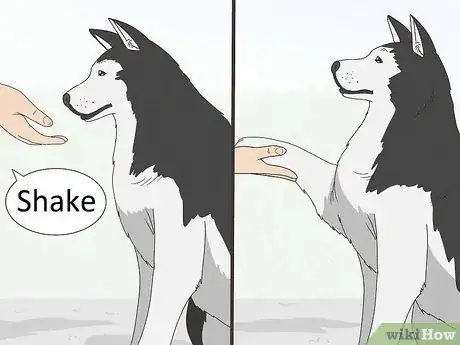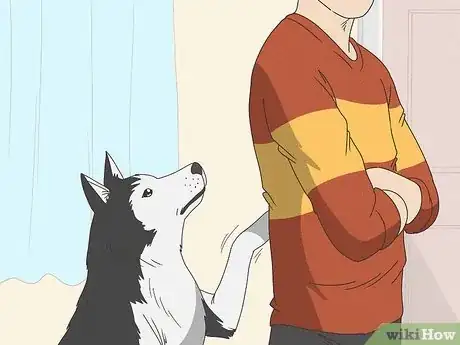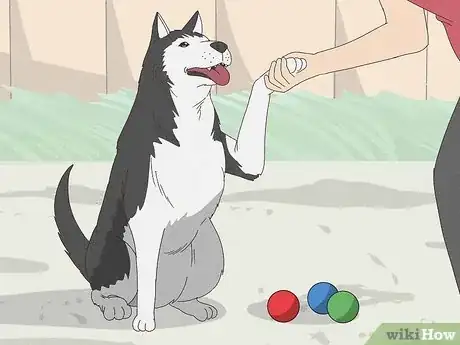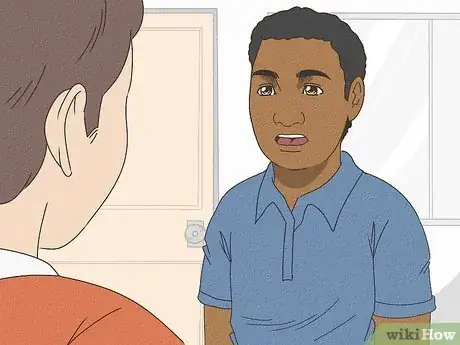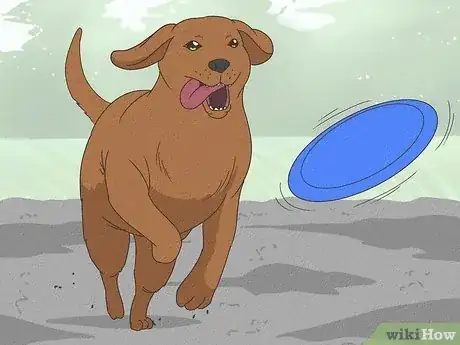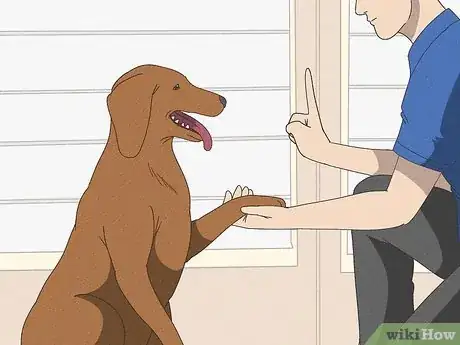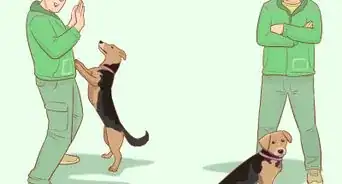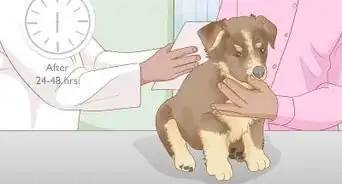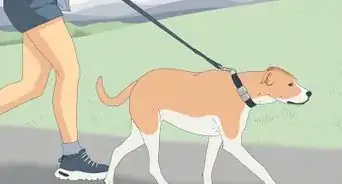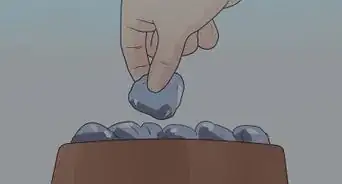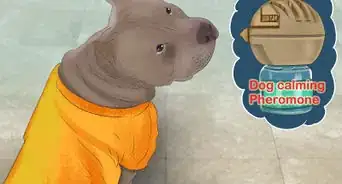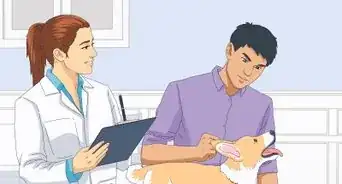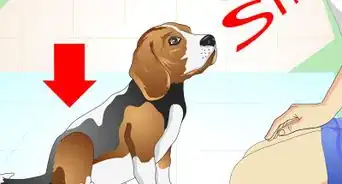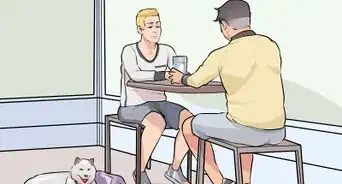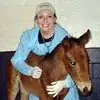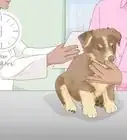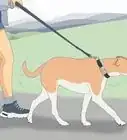This article was co-authored by Ryan Corrigan, LVT, VTS-EVN. Ryan Corrigan is a Licensed Veterinary Technician in California. She received her Bachelor of Science in Veterinary Technology from Purdue University in 2010. She is also a Member of the Academy of Equine Veterinary Nursing Technicians since 2011.
This article has been viewed 23,679 times.
Pawing can be a frustrating behavior to deal with as a dog owner. Unwanted pawing can be annoying and, if aggressive enough, even cause pain. Luckily, there are many ways you can reduce your dog's pawing. Teach your dog to engage in other behaviors, such as tricks, to gain attention. Ignore pawing when it occurs to prevent reinforcing the behavior. If your dog's pawing is due to nerves and issues with separation, working on keeping your dog feeling calm and secure. With a few adjustments to your schedule, you can eliminate your dog's pawing.
Steps
Encouraging Alternative Behaviors
-
1Ask for a command instead when your dog paws. Dogs often paw as a means to get attention or food. If your dog is pawing, a good way to prevent is to encourage them to engage in other behaviors to gain attention. If your dog knows any tricks or commands, have your dog engage in these behaviors when it paws.[1]
- For example, your dog may paw when it wants attention. Each time you see your dog pawing, say, "Sit!" Do not reward your dog with attention until it sits. This way, your dog will learn to sit quietly and wait for attention instead of pawing.
-
2Teach your dog to "shake" instead of paw. Pawing can also be converted into a trick. If a dog associates the pawing behavior with the command, "Shake," it will eventually learn only to paw when it hears that command.[2]
- Hold your hand in front of your dog and say "Shake." Wait for your dog to paw at your hand and then reward it with a treat and praise. Repeat this several times a day until your dog understands to paw when it hears, "Shake."
- After your dog learns the "shake" command, only reward your dog with attention or food when it paws in response to the command. Eventually, your dog will learn pawing is only appropriate when you ask it to shake.
Advertisement -
3Be consistent. Whichever behavior you choose to encourage, be consistent. Dogs learn best with consistent training over time. Make sure to only reward your dog with treats or praise when it engages in the behavior you want instead of pawing. If you notice pawing at any other times, ignore the behavior and do not reward your dog. Most dogs paw because they want attention or food. If you engage with them while they're pawing, they will continue the behavior.[3]
- For example, if you want your dog to sit when it wants food instead of pawing, do not feed your dog until it sits. If your dog is pawing, patiently command your dog to sit and only give it food when it obeys.
Providing Positive and Negative Reinforcement
-
1Ignore pawing. Dogs respond to any kind of attention, even negative attention. If your dog is pawing, the best way to discourage the behavior is simply ignoring it. When your dog paws you, freeze completely and avoid making eye contact with the dog. Do not engage with the dog until the behavior stops.[4]
- When you initially start ignoring your dog, it will probably paw you harder to try to get your attention. Be patient and do not engage with the behavior. Engaging with pawing after your dog becomes more aggressive encourages your dog to paw.
- Ignoring bad behavior is much more effective than scolding your dog, as scolding is seen as a form of attention.
- If ignoring your dog isn’t working or is getting annoying or painful, trying getting up and moving away from your dog to avoid them and not reward their pawing.
-
2Manage pawing during playtime. It's natural for dogs to paw during playtime to an extent. However, unwanted and aggressive pawing should be discouraged. If your dog paws you during play, stop playing with your dog for 10 to 30 seconds. Continue playing once your dog has calmed down and their paws are on the floor. Then, resume playing. If you consistently halt playing in response to pawing, your dog will eventually learn not to paw.[5]
- Also, keep toys low to the ground when playing with your dog. This will prevent your dog from having to paw to get its toys.
-
3Reward only pawing that occurs on cue. Remember, consistency is key to cut back on any unwanted behavior. Only engage with your dog's pawing when it comes in response to a specific command, like, "Shake." Responding to any other type of pawing will encourage unwanted pawing.[6]
-
4Make sure others know not to encourage pawing. Many people accidentally reinforce pawing without realizing it. Guests, friends, and relatives may be naturally inclined to pet a dog that's pawing them for attention. If you have new people over, politely let them know you're working on discouraging your dog's pawing. Most people will be receptive when you explain that you’re trying to break your dog of an annoying habit. Ask them to refrain from engaging with your dog if it starts pawing.[7]
Keeping Your Dog Calm
-
1Make sure your dog gets regular feedings and bathroom breaks. Dogs thrive on a schedule. Sometimes dogs paw or exhibit other types of unwanted behavior in order to communicate their basic needs to you, such as needing to go outside or be fed. Take your dog out and feed it consistently and frequently in order to keep it calm and minimize pawing.
-
2Make sure your dog gets enough exercise. Oftentimes, dogs will become nervous and seek out attention if they're not getting enough exercise. This can cause attention-seeking behavior such as pawing. If your dog is pawing a lot, try upping its exercise routine. Play with your dog more often and take it for daily walks.[8]
- Talk to your vet about how much exercise is safe for your dog, especially if your dog is a senior or if it has underlying health problems.
-
3Play retrieving games. Retrieving games are great for dogs with anxiety as they keep your dog focused and active. If your dog has pawing issues, play games like fetch to keep your dog calm.[9]
- If your dog paws you during a game, pause the game until the pawing stops.
-
4Provide your dog with space to relax. Dogs that have anxiety issues may not feel like they have space to relax in your home. If your dog is pawing and displaying other nervous behaviors, such as pacing or barking, evaluate your home. Make sure your dog has their own bed and easy access to food and water. Make sure your dog has access to rooms where you hang out frequently, such as the living room, as dogs that feel isolated may engage in attention seeking behaviors.[10]
-
5Consider taking an obedience class if problems persist. If pawing does not stop with increased exercise, play, and comfort, find obedience classes in your area. Very nervous dogs that are prone to behavioral issues can benefit from professional training.[11]
- You can find training programs online or ask your vet for a recommendation.
- Trainers can also help you work through other unwanted behaviors with your dog, such as jumping.
References
- ↑ http://www.vetstreet.com/our-pet-experts/5-tips-on-how-to-stop-a-dog-from-pawing
- ↑ http://www.embracepetinsurance.com/training/pawing-scratching
- ↑ http://www.embracepetinsurance.com/training/pawing-scratching
- ↑ http://www.vetstreet.com/our-pet-experts/5-tips-on-how-to-stop-a-dog-from-pawing?page=2
- ↑ http://www.vetstreet.com/our-pet-experts/5-tips-on-how-to-stop-a-dog-from-pawing?page=2
- ↑ http://www.dailydogdiscoveries.com/stop-my-dog-from-pawing-me/
- ↑ http://www.dailydogdiscoveries.com/stop-my-dog-from-pawing-me/
- ↑ http://www.thelabradorsite.com/attention-seeking-dog/
- ↑ http://www.thelabradorsite.com/attention-seeking-dog/
About This Article
Pawing can be a frustrating behavior, but you can stop it by teaching your dog to “shake” instead of paw. Do this by holding your hand in front of your dog and giving the command “Shake.” Wait for your dog to paw at your hand and when it does, give it a treat and praise. It might seem counterintuitive to reward your dog for pawing, but this will eventually teach it that pawing is only okay when you ask it to shake. If you notice it pawing at any other time, ignore it and never reward the behavior with attention or food. Be sure to never yell or scold your dog, even if ignoring it doesn’t work, because negative attention is still going to reinforce the behavior. Instead, move away from your dog and do not make eye contact. For more help from our Veterinary co-author, like how to relieve anxiety issues that might be causing the pawing, read on!

